ISIS Redux: The Central Syria Insurgency in February 2023
Following is the February 2023 installment of “ISIS Redux: The Central Syria Insurgency,” a monthly chronicle of attacks by the terrorist group ISIS in central Syria. A review of developments throughout 2022 and 2021 can be found here and here. The January 2023 edition can be found here. A full background and analysis of ISIS’s resurgence in Syria, including the methodology used to collect this data, can also be explored here, here, and here.
ISIS carried out at least 21 confirmed attacks in February in Homs, Hama, and Deir Ez Zor governorates. These attacks killed at least 13 pro-Assad regime soldiers and at least 80 civilians, while wounding at least 34 additional soldiers and civilians. Additionally, there were six high quality* attacks in February. February had more confirmed ISIS attacks than any of the past 16 months and, based on confirmed casualties, was the deadliest month in central Syria since the insurgency began in early 2019. The majority of this month’s deaths came during the brutal February 17 ISIS attack on a large group of civilians and their small security escort who were truffle hunting near Wadi Doubayat, south of Sukhnah in Homs. However, there were additional reports of multiple days of heavy fighting between ISIS and security forces along the Arak-Sukhnah front in the days preceding this attack. It is unclear whether additional pro-regime fatalities occurred during these battles.
However, as in January, ISIS itself claimed no attacks in central Syria in February. Unlike past months, February’s activity was both more aggressive (at least 11 of the 21 confirmed attacks involved small arms, rather than simple mines or Improvised Explosive Devices (IED) and focused heavily in eastern Homs, rather than Raqqa and Deir Ez Zor). While this author could not confirm any specific attacks in southern Raqqa this month, a regime soldier with contacts in Tabqa confirmed in a late-February interview that there are still ISIS cells in the Tabqa area occasionally attempting IED attacks. Of potential significance, February was also the first month since September 2021 in which there were confirmed ISIS small arms attacks in eastern Hama (versus mine or IED attacks), indicating either a renewed or continued ISIS presence on the ground in the governorate.
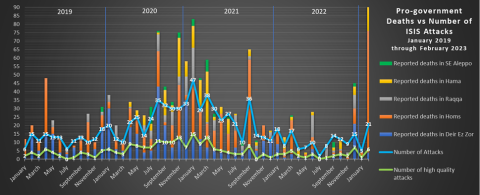
ISIS attacks rose sharply in Homs (12) while increasing slightly in Deir Ez Zor (4) and Hama (5). No attacks were confirmed in south Aleppo or south Raqqa in February.
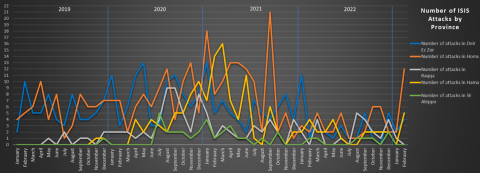
Homs and Deir Ez Zor
The bulk of ISIS activity in February occurred in eastern Homs, particularly around the Sukhnah-Arak-T3 axis. On February 5, two trucks carrying civilian truffle hunters hit mines near Arak, leaving 10 wounded. That same day a soldier from Tartous was reported killed near Palmyra. Two days later, on the night of February 7, ISIS fighters reportedly set up a fake checkpoint near Arak, triggering heavy clashes with security forces. It is unknown whether casualties occurred. This was the first confirmed use of a fake checkpoint since March 2021. On February 10, another soldier from Tartous was reported killed near Palmyra.
The next three days saw continuous clashes between ISIS cells and regime forces, as well as the first major attack on civilian truffle hunters. ISIS clashed with National Defense Forces (NDF) and Syrian Arab Army (SAA) units stationed around Arak on February 11 and 12, while another cell ambushed a group of truffle hunters east of the T3 Station on February 11, killing at least four and injuring 10. On February 13, local security forces reported that a member of Russia’s Wagner PMC had been temporarily captured by ISIS during heavy fighting near the T3 Station but was freed during a Wagner counterattack. On February 14, a military intelligence fighter was reported missing in action during a patrol in the Jabal Bala’as region north of Palmyra. This author was unable to confirm the number of casualties regime forces suffered during these three days of fighting, but it is clear that multiple ISIS cells launched sustained attacks on the Arak-T3 axis.
The next major encounter occurred on February 17, when multiple ISIS cells launched simultaneous attacks against both security forces and civilians. Two cells ambushed a group of more than 150 civilian truffle hunters and their small security escort in the Wadi Doubayat area, which has long been under ISIS control. As one cell initiated the attack, a second reportedly moved in and ambushed fleeing civilians. At least 59 civilians and seven police officers were killed. ISIS fighters reportedly stole six trucks and several rifles. Local security forces who later arrived on the scene reported that some of the civilians had been decapitated and found notes left behind warning locals against “working with the regime.” Meanwhile, a third cell launched an attack on the largest SAA position outside Arak, though the soldiers were able to repel it.
After this, confirmed activity in east Homs largely ended. The only other documented attack occurred on February 25 when two soldiers were reportedly wounded by a mine “in the Badia,” likely somewhere in eastern Homs.
ISIS activity rose slightly in Deir Ez Zor in February, though all confirmed incidents involved mines or IEDs. On February 3, a field commander from an Iranian-backed militia was killed by a mine somewhere in the western countryside. On February 17, two local militiamen were killed by an explosion in the Quriyah desert, southwest of Mayadin. On February 21 a police officer from Damascus was killed by a mine near Harbisha, and on February 24 at least one NDF fighter was wounded by a mine while looking for truffles outside of Zabari, north of Mayadin. Local opposition sources claimed three other NDF soldiers were wounded in the same incident, though no pro-regime sources could corroborate the assertion.
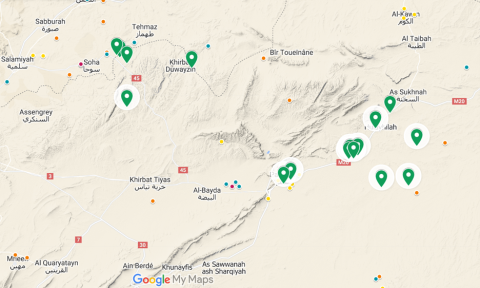
Map of locatable ISIS attacks in Homs (highlighted) in February 2023 alongside attacks in 2022. Note that the map does not include one attack conducted somewhere in “the Badia”.
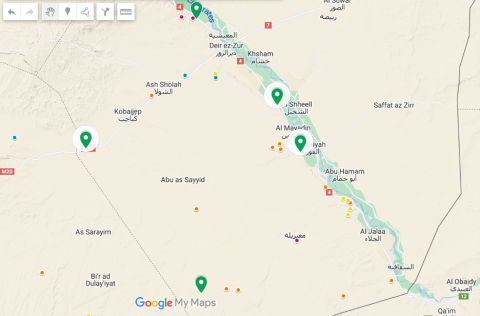
Map of locatable ISIS attacks in Homs (highlighted) in February 2023 alongside attacks in 2022. Note that the map does not include one attack somewhere in the Deir Ez Zor countryside.
Hama and Raqqa
ISIS conducted four attacks in eastern Hama in February, two of which involved small arms for the first time since September 2021. It should be remembered that ISIS’s original push into east Hama in early 2021 coincided with its massive Badia expansion. This is not to say that ISIS is on the verge of another large surge in activity in central Syria, simply that eastern Hama has always been a peripheral front for its insurgency and a return to more aggressive activity here may indicate that ISIS has re-stabilized and strengthened its ‘core’ Badia fronts and can now dedicate more resources to ‘frontline’ regions like Hama.
On February 10, a local teenager was wounded by a mine near Ithriyah while searching for truffles. On February 14, local pages reported a truffle hunter was shot and a second man was kidnapped near Duwayzin, southeast of Uqayribat. The next day, three more truffle hunters were shot to death near Tel Salamah, east of Uqayribat. On February 27, a large group of truffle hunters drove over two mines near Tel Salamah, leaving 10 dead and nine wounded. Finally, on March 2, local pages reported that the bodies of four truffle hunters who had gone missing “several days earlier” were found southeast of Tel Salamah. The posts did not mention if the people were killed by a mine, likely meaning they were killed by small arms, similar to the February 10 and 14 incidents.
ISIS began its revamped Badia media strategy in August with a string of southern Raqqa claims. ISIS cells carried out at least 16 attacks in southern Raqqa between August and December 2022, compared to just seven attacks in the first seven months of the year. Activity in Raqqa continued at a reduced rate in January, and no confirmed attacks could be confirmed in February. (It is important to remember that southern Raqqa is one of the most difficult places to find accurate information on ISIS activity.) However, one regime soldier with long-time contacts in Tabqa told this author on February 25 that ISIS cells were still actively attempting to conduct IED attacks in the area.
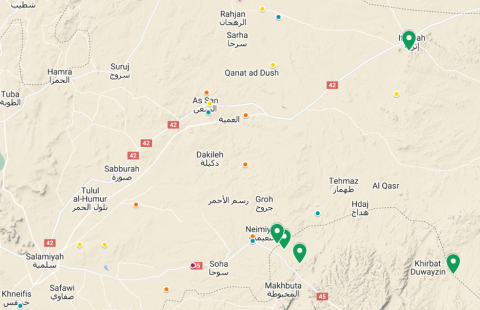
Map of locatable ISIS attacks in February 2023 alongside attacks in 2022. Note that the author does not know the exact location of Tel Salamah, only that it is east of Uqayribat, and therefore the three Tel Salamah attacks have been placed around the town of Uqayribat.
Looking Ahead
Despite the record low in attacks in January, ISIS activity in central Syria surged in February, consistent with the otherwise general trend of both increased quantity and aggressiveness of attacks that began in August 2022. However, it is important to remember that while the Badia insurgency is intricately tied to the northeast insurgency, much of the week-to-week kinetic activity is locally driven. Nine of February’s 20 confirmed attacks targeted truffle hunters—as happens every year around this time. Truffle picking is one of the most lucrative activities for the people struggling to scrape by in central Syria, and so many civilians venture deep into the countryside in areas not under full control by the regime. They thus present easy targets for ISIS cells that are often based or transiting nearby. Some civilians and shepherds in central Syria play key intelligence gathering roles for both the regime and ISIS, and civilians are therefore frequently targeted by ISIS to dissuade others from reporting on their activities to security forces.
Therefore, it is unlikely that the following months will see the same number of attacks or casualties as in February. As civilian movement into the deep Badia is reduced, ISIS cells will return to their more standard set of targets. The past year has also shown a high degree of fluctuation in ISIS activity, with cells seeming to engage in one- to two-week bursts, following by several weeks of reduced attack frequency. The apparent expansion back into, or re-activation of cells in eastern Hama is unlikely to precipitate any sort of large surge similar to early 2021. Rather, ISIS is likely to maintain a fluctuating level of five to 15 attacks per month. The key is that, per consistent reporting from regime security services over the past year, ISIS cells are constantly monitoring regime outposts and movement. ISIS does not appear willing to risk significant human or materiel losses at this time, and so it has adopted a more cautious strategy of waiting for weaker targets, such as small convoys, undermanned outposts, or patrol routes that can be mined. We are therefore likely to see the occasional high profile attack—like those on February 17—but should be wary of interpreting them as signs of a new, sustained ISIS offensive.
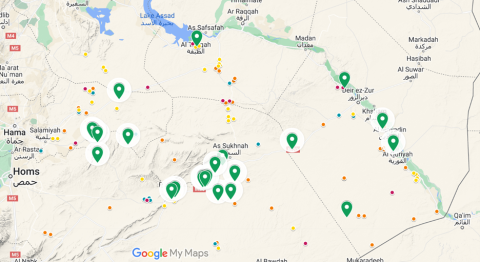
Map of locatable ISIS attacks (highlighted) in February 2023 alongside January 2023 (green, not highlighted) and attacks in 2022. Note that it does not include one attack conducted somewhere in “the Badia” and one in the Deir Ez Zor countryside. To view an interactive version of this map, please click here.
---
*High quality attacks are defined as attacks behind frontlines, those that result in seized positions, target regime officers, involve coordinated attacks on multiple positions, fake checkpoints, ambushes on military convoys, or attacks on checkpoints that kill at least three soldiers or lead to POWs.
Stay up to date on our latest news.
Get the latest news on extremism and counter-extremism delivered to your inbox.